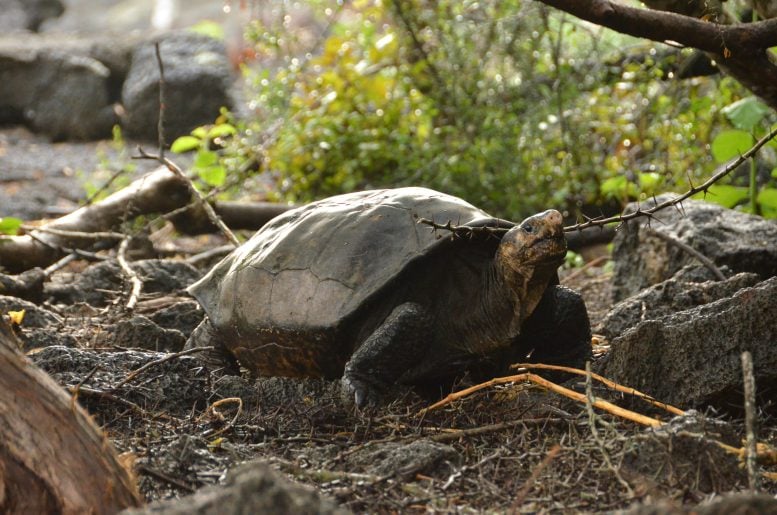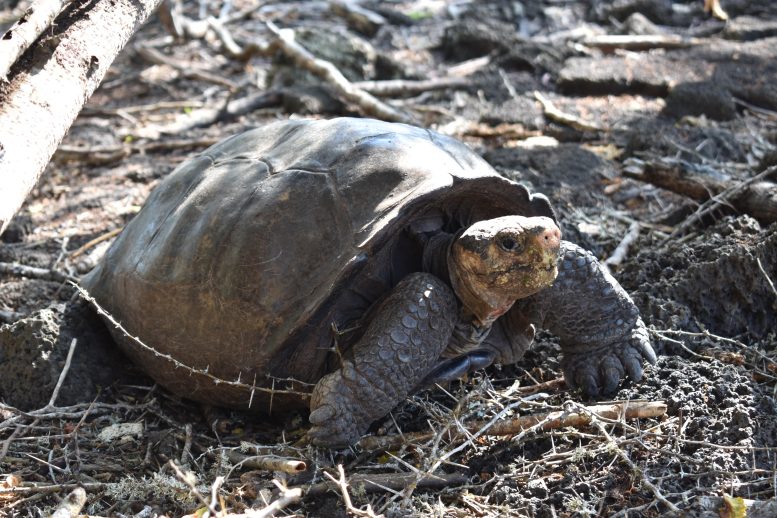
The discovery of a lonely tortoise doubles the number of known individuals of the “phantasticus” species.
Evolutionary scientists were perplexed by the finding of a single, little female tortoise in 2019 that lives on one of the Galapagos Islands’ most isolated islands. Only one other tortoise, a huge male discovered in 1906, has ever been discovered on Fernandina Island, an isolated island on the renowned archipelago’s western tip.
According to research from Yale University published in the journal Communications Biology, Fernanda, what the scientists named the 50-year-old tortoise, and the male specimen from the 20th century now kept at the California Academy of Sciences, are closely related. This discovery doubles the number of known members of Chelonoidis phantasticus.
However, the finding has sparked many new questions.
“Vast amounts of the genomes are similar between the two animals, but the process that explains how this happened we just don’t know,” said Adalgisa Caccone, a senior research scientist and lecturer in Yale’s Department of Ecology & Evolutionary Biology and senior author of the study. “This also shows the importance of using museum collections to understand the past.”

According to the nonprofit organization Galapagos Conservancy, there are thought to be 15 different species of giant tortoises on the Galapagos Islands.
The new discovery clearly shows that the two tortoises discovered on Fernandina Island belong to their own lineage and are more closely related to each other than to any other species of Galapagos tortoises, whose numbers have been reduced by 85% to 90% since the early nineteenth century, owing largely to the arrival of whalers and pirates who killed them for food.
“The finding of one alive specimen gives hope and also opens up new questions as many mysteries still remain,” said Caccone, a member of Yale’s Faculty of Arts and Sciences. “Are there more tortoises on Fernandina that can be brought back into captivity to start a breeding program? How did tortoises colonize Fernandina and what is their evolutionary relationship to the other giant Galapagos tortoises?”
Extinction Fears
The tortoises of Fernandina Island were believed to have been driven to extinction by volcanic eruptions on the island, including approximately 25 in the last two centuries. Areas of vegetation, scientists have theorized, were reduced by lava flows.

The Galapagos National Park and the Galapagos Conservancy plan to scour the island of Fernandina for relatives of Fernanda in hopes of preserving the species. The presence of additional tortoise scats and tracks suggests they may find more animals on the island, Caccone said. If more tortoises are found, she said, conservationists could start a captive breeding program.
Evolutionary Mysteries and Possible Hybrid Origins
Deciphering the evolutionary relationship between the two Fernandina tortoises might be trickier. For one thing, they look very different. The male specimen has a large and protruding carapace characteristic of saddleback tortoises, while Fernanda has a smaller, smoother shell. Caccone thinks that this shape difference is possibly due to stunted growth as a result of limited food options.
And while the genomes of the two animals are very similar, researchers discovered differences within the mitochondria, the energy-producing portion of cells that are passed down maternally. Since mitochondrial DNA is inherited from the mother, Caccone said it is possible that Fernanda is a hybrid, the progeny of a Chelonoidis phantasticus male and a C. nigra female, a now extinct species from the island of Floreana, the larger neighbor of Fernandina.
Humans are known to have moved different tortoise species, such as C. nigra, between the Galapagos islands — including Isabela island, where many hybrids between the endemic species C. becki and the extinct C. nigra have been found. It is possible that a C. nigra female similarly found its way to Fernandina and mated with a male from C. phantasticus, leaving its mitochondrial DNA to all her descendants.
Caccone thinks that the male now housed in the California museum is probably a true representative of the original species. But to solve this new puzzle, she said, more tortoises from Fernandina need to be found.
Evolutionary biologists will work on these and other questions in the coming years.
Importance of Protecting Galapagos Tortoises and Their Ecosystem
“These tortoises are the largest cold-blooded terrestrial herbivore on Earth and have a very important ecological role,” Caccone said. “So protecting them is important not only because of their iconic status but also because they are an important agent of ecosystem stability in the Galapagos.
“There is still a lot we don’t know, and what we learn will provide guidance to help protect them and with them the fragile and unique place on Earth they call home.”
Reference: “The Galapagos giant tortoise Chelonoidis phantasticus is not extinct” by Evelyn L. Jensen, Stephen J. Gaughran, Nicole A. Fusco, Nikos Poulakakis, Washington Tapia, Christian Sevilla, Jeffreys Málaga, Carol Mariani, James P. Gibbs and Adalgisa Caccone, 9 June 2022, Communications Biology.
DOI: 10.1038/s42003-022-03483-w
The study was funded by the Galápagos National Park Directorate, the Galápagos Conservancy, the Mohamed bin Zayed Species Conservation Fund, Re:Wild, Island Conservation, the Ecuadorian Ministry of the Environment, the U.S. Fish and Wildlife Service, the California Academy of Sciences, and the Yale Center for Research Computing.
Never miss a breakthrough: Join the SciTechDaily newsletter.
1 Comment
I encountered a large turtle in Northern New Mexico off interstate 25 that was 18 in in diameter and about 30 lb in weight in about 12 in height, would this high desert turtle be related to the Galapagos tortoise.